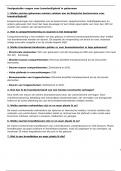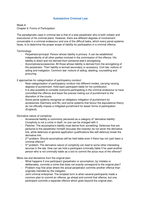Skin physiology
Contains three layers:
1. Epidermis: keratinocytes (squamous epithelial cells)
2. Dermis: connective tissue, vessels
3. subcutaneous fat
Stratum Basalis:
contains stem cells that can
regenerate keratinocytes
Stratum Spinosum:
This contains cells with spines, the
spines are formed by desmosomes.
Desmosomes are connections
between keratinocytes.
Stratum Granulosum:
Cells contains keratohyalin granules,
which are used to form keratin
filaments.
Stratum Lucidum:
Clear layer of dead skin cells
Stratum Corneum:
Anucleated cells
Cells are filled with keratin filaments.
(tough outer layer of skin)
Skin physiology 1
, Dermis:
Contains blood vessels (unlike
epidermis)
Connective tissue
Skin lesions:
Primary lesions:
Directly caused by disease
Macules, papules, vesicles and bulla
Secondary lesions:
modification of primary lesion, or
caused by trauma/external factor
Scale, crust, erosion, fissure and
ulcer
Primary skin lesions:
Macules and Patches:
Flat lesions (not raised)
Macule < 1cm
Patch > 1cm
Papules and Plaques:
Raised lesions
Papule < 1cm
Plaques >1cm
Skin physiology 2
, Maculopapular rash:
Collection of macules (flat) and
papules (raised) lesions
Sometimes described as Morbilliform
(looks like measles)
Common in:
Drug rash
Scarlett fever
Measles
Syphilis
Rubella
Vesicles and Bulla:
Fluid filled lesions (blisters)
Vesicle < 1cm (chicken pox)
Bulla > 1cm (bullous pemphigoid)
Pustule:
Pus filled vesicle
Normally contains a white centre
Secondary skin lesion:
Scale:
Secondary lesion
Skin physiology 3










